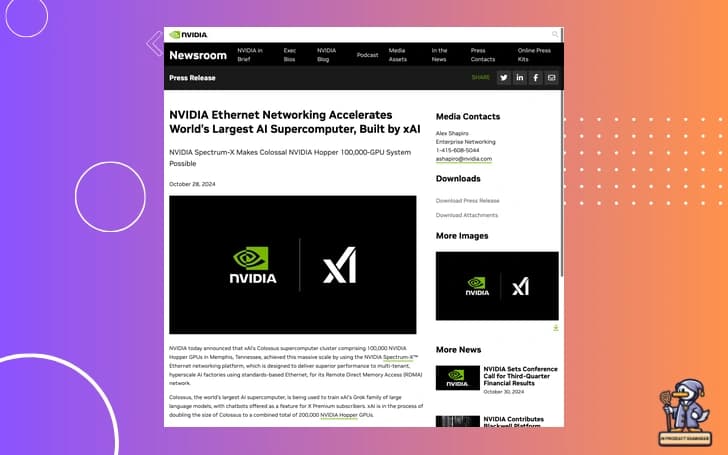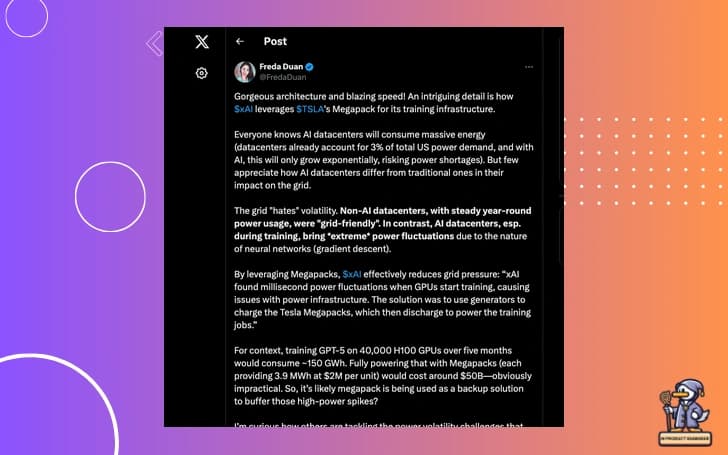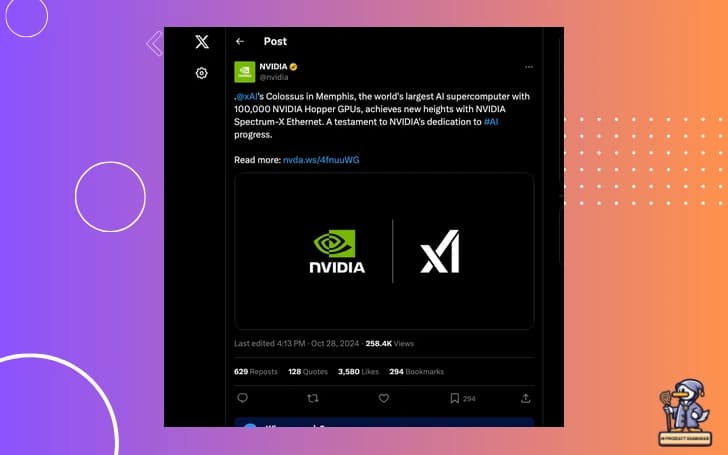🎉 Welcome Back, Ducktypers!

Hello everyone, Jens here. Today we're diving deep into what might be the most ambitious AI infrastructure project of 2024: xAI's Colossus supercomputer. As a systems architect, I've spent considerable time analyzing the recently released technical details, and I'm excited to share my engineering perspective on this remarkable system.
In this comprehensive analysis, we'll explore:
- The innovative vertical rack design housing 100,000 NVIDIA H100 GPUs
- A breakthrough networking approach achieving 95% throughput efficiency
- A sophisticated three-tier power management system using Tesla Megapacks
- An advanced liquid cooling solution handling 70MW of heat dissipation
- The strategic expansion plan to 200,000 GPUs using a hybrid H100/H200 approach
What makes Colossus particularly interesting from an engineering standpoint is not just its scale, but the numerous technical innovations it introduces. We'll examine how xAI solved critical challenges in power delivery, cooling, and networking that were previously considered insurmountable at this scale.
Let's dive into the technical details...
🏗️ Physical Architecture
Let's start by examining the rack configuration of Colossus, which uses a fascinating vertical stacking approach:
This diagram shows the vertical organization of a single rack in the Colossus system. Let me break down what we're looking at:
-
Server Units: Each rack contains three 4U Supermicro servers (R1, R2, R3), with each server housing 8 NVIDIA H100 GPUs. This gives us 24 GPUs in the compute portion.
-
Cooling System: Between each server, we have 1U cooling manifolds (M1, M2, M3). These manifolds are crucial for the liquid cooling system, distributing coolant to each GPU. The arrangement ensures uniform cooling across all GPUs in the rack.
-
Pump System: At the bottom of the rack sits a 4U pump system (R4), which manages the coolant circulation for the entire rack. This redundant pump system also includes rack monitoring capabilities.
-
Total Configuration:
- 3 servers × 8 GPUs = 24 GPUs per rack
- 3 cooling manifolds × 1U = 3U for cooling
- 3 servers × 4U = 12U for compute
- 1 pump system × 4U = 4U for cooling management
- Total rack height = 19U
This configuration is replicated across the facility, with groups of eight racks forming arrays of 512 GPUs (8 racks × 64 GPUs). The modular design allows for efficient maintenance and optimal cooling performance, which is crucial when dealing with the heat output of high-density GPU computing.
📦 Supermicro Server Internal Architecture

Let's examine the internal layout of each Supermicro 4U Universal GPU server:
Supermicro 4U Universal GPU Layout:
┌───────────────────────────────┐
│ H100-1 H100-2 H100-3 H100-4│
│ H100-5 H100-6 H100-7 H100-8│
│ PSU-1 PSU-2 PSU-3 PSU-4 │
│ COOLING MANIFOLD CONNECTIONS │
└───────────────────────────────┘
I prepared above a diagram showing the internal organization of each 4U server unit. Here's what we're looking at:
-
GPU Arrangement:
- Top row: Four H100 GPUs (1-4) arranged horizontally
- Second row: Four more H100 GPUs (5-8) completing the 8-GPU configuration
- This arrangement optimizes airflow and thermal distribution
-
Power Supply Redundancy:
- Four independent PSUs (Power Supply Units)
- This N+1 redundancy ensures the system remains operational even if one PSU fails
- Each PSU is hot-swappable for maintenance without system downtime
-
Cooling System Integration:
- Bottom row dedicated to cooling manifold connections
- Direct liquid cooling to each GPU
- Hot-swappable cooling connections for maintenance flexibility
From an engineering perspective, this layout achieves several critical objectives:
- Optimal thermal management through balanced GPU positioning
- Maximum serviceability with hot-swappable components
- Redundant power delivery for high availability
- Efficient space utilization in the 4U form factor
This design demonstrates why the Colossus system can achieve such high density while maintaining reliable operation. The careful attention to component placement and cooling is crucial for managing the approximately 700W of power each H100 GPU can consume under load.
🌐 Network Architecture
Once we start looking at it deeper, we notice how the network topology of Colossus implements a unique approach to AI cluster networking. For this, I prepared this graph:
This topology is interesting for several reasons:
-
Dedicated NICs Per GPU:
- Each H100 GPU has its own dedicated 400GbE NIC
- This is unusual as most systems share networking resources between GPUs
- Results in 3.2 Tbps bandwidth just for GPU communication (8 × 400 GbE)
-
Additional Host Bandwidth:
- Separate 400GbE NIC for the host system
- Brings total bandwidth to 3.6 Tbps per server
- Ensures host operations don't compete with GPU traffic
-
Ethernet-Only Architecture:
- Breaks from traditional supercomputer design that typically uses InfiniBand
- Achieves comparable performance using standard Ethernet technology
- Simplifies maintenance and reduces costs while maintaining performance
-
NVIDIA Spectrum-X Innovation:
- Achieves 95% data throughput (vs 60% with standard Ethernet)
- Eliminates flow collisions that typically plague large Ethernet networks
- Enables zero application latency degradation across the fabric
This design choice represents a significant departure from conventional supercomputer networking approaches, demonstrating that properly architected Ethernet can match or exceed traditional HPC interconnects when properly implemented.
📊 Network Performance Analysis

But of course, at the end of the day what matters is performance, and specifically, performance in comparison to other alternatives. So, let's examine how NVIDIA's Spectrum-X technology compares to standard Ethernet in real-world performance. For this, I made this small table that should help us put things in perspective:
Network Performance Metrics:
Standard Spectrum-X
Throughput: [===== ]60% [========]95%
Flow Collisions: [!!!!!!!] [ ]
Latency Impact: [++++++] [ ]
─────────────────────────────────────────────
Scale: 20% per block, ! = collisions, + = added latency
Looking at it, we notice that this comparison reveals three critical performance aspects:
-
Throughput Efficiency:
- Standard Ethernet only achieves 60% of theoretical bandwidth
- Spectrum-X reaches 95% of theoretical bandwidth
- This 35% improvement is crucial for AI training workloads
- In practical terms, this means a 400GbE link delivers ~380Gbps vs just 240Gbps
-
Flow Collisions:
- Standard Ethernet shows thousands of flow collisions
- These collisions force packet retransmission, wasting bandwidth
- Spectrum-X completely eliminates flow collisions through advanced traffic management
- This is particularly important for distributed AI training where any packet loss can stall computation
-
Latency Characteristics:
- Standard Ethernet exhibits significant added latency due to congestion
- Spectrum-X maintains consistent latency even under heavy load
- Low, predictable latency is essential for maintaining GPU synchronization during training
- Each '+' represents approximately 5µs of added latency in the standard setup
This performance difference explains why Colossus can achieve unprecedented training speeds despite using Ethernet instead of traditional HPC interconnects like InfiniBand. The near-zero packet loss and consistent latency are particularly crucial for distributed AI workloads where any communication hiccup can force expensive recomputations.
The practical impact of these improvements means Colossus can maintain near-linear scaling across its 100,000 GPUs, something previously thought impossible with standard Ethernet networking.
⚡ Power Distribution System
The power architecture of Colossus is particularly innovative because it solves unique challenges in AI infrastructure power management:
This three-tier power system addresses several critical challenges:
-
Base Power Infrastructure:
- Power grid provides primary power
- 14 diesel generators offer backup capacity
- Tesla Megapacks act as an intermediate buffer
- Distribution system feeds multiple rack arrays
-
Why This Matters:
- AI training creates extreme power fluctuations
- Traditional power infrastructure can't handle millisecond-level spikes
- Grid operators typically require more stable loads
- This system provides multiple layers of power stability
So, with this in mind, let's consider how power consumption patterns tend to look like. I prepared this basic representation that should help us get a better idea:
Power Usage Pattern (Representative):
Normal Operation: ▅▅▆▅▅▆▅▅▆▅▅
Training Spike: ▅▅█████▅▅▆▅▅
Megapack Buffer: ▅▅▅▅▅▅▅▅▅▅▅
─────────────────────────────────
Time → (milliseconds)
If that does not make too much sense, let me explain. This pattern visualization shows three critical aspects:
-
Normal Operation:
- Regular power draw with minor fluctuations
- Peaks around 60-70% of maximum capacity
- Predictable pattern that grid can handle
-
Training Spikes:
- Sudden jumps to maximum power draw
- Can last several milliseconds
- Could destabilize traditional power systems
- Common during gradient descent operations
-
Megapack Buffer Effect:
- Smooths out all variations
- Presents stable load to the grid
- Absorbs both spikes and troughs
- Enables consistent operation
The significance of this design is that it allows Colossus to:
- Handle peak loads of multiple megawatts
- Maintain grid stability
- Operate continuously despite power fluctuations
- Scale to 200,000 GPUs in the future
For context, each H100 GPU can spike to 700W during training, meaning the system must handle power swings of several megawatts in milliseconds - something traditional data center power systems aren't designed to do.
🌡️ Cooling System Architecture

Now, let us talk about how they want to keep things cool. The cooling system in Colossus represents a sophisticated approach to thermal management, which is crucial when dealing with 100,000 H100 GPUs. Let's examine the liquid cooling implementation:
Let me break down why this cooling system is critical:
-
Closed Loop Design:
- Primary pump circulates coolant continuously
- Each rack has its own independent cooling loop
- Redundant pumps ensure continuous operation
- Minimizes potential points of failure
-
Manifold System:
- Each 1U manifold distributes coolant to 8 GPUs
- Ensures equal cooling pressure across all GPUs
- Enables hot-swapping of servers without disrupting cooling
- Monitors coolant temperature and flow rates
-
Heat Exchange Process: Let me share a simple Python class I created to help visualize the heat management challenge we're dealing with:
class CoolingLoop:
def __init__(self):
self.gpu_heat_output = 700 # Watts per GPU
self.gpus_per_server = 8
self.servers_per_rack = 8
self.total_heat_per_rack = (
self.gpu_heat_output *
self.gpus_per_server *
self.servers_per_rack
) # ~44.8 kW per rackThis code helps us understand the scale of the cooling challenge. Let me break down why these numbers are crucial:
- Each H100 GPU outputs 700W of heat under load - that's equivalent to 7 high-power household light bulbs
- With 8 GPUs per server and 8 servers per rack, we're managing 44.8 kW of heat in a single rack
- To put this in perspective, 44.8 kW could heat about 4-5 residential homes in winter
- When we scale this to all racks in Colossus, we're handling enough heat to warm a small town
From an engineering perspective, this heat density is what drove many of the design decisions:
- The need for liquid cooling (water has 3,500 times the heat capacity of air)
- The requirement for redundant pumping systems
- The careful placement of manifolds between servers
- The implementation of real-time temperature monitoring
- Temperature Management:
- Inlet temperature: 20°C
- GPU maximum temperature: 75°C
- Heat exchanger delta: 55°C
- Flow rate: Approximately 4 gallons per minute per GPU
This cooling architecture is essential because:
- Each H100 GPU generates up to 700W of heat
- Traditional air cooling would be insufficient
- System must maintain stable temperatures for optimal performance
- Cooling efficiency directly impacts training speed
The liquid cooling system achieves several critical objectives:
- Maintains optimal GPU temperature under full load
- Enables high-density rack configuration
- Reduces overall energy consumption compared to air cooling
- Provides redundancy for continuous operation
📊 Scale Analysis
Let's examine the hierarchical scale of Colossus to understand its massive infrastructure. This visualization helps us grasp the exponential growth from a single server to the full system:
System Scale Visualization:
1 Server: 8 GPUs [▇ ]
1 Rack: 64 GPUs [▇▇ ]
1 Array: 512 GPUs [▇▇▇ ]
Phase 1: 100k GPUs [▇▇▇▇▇ ]
Phase 2: 200k GPUs [▇▇▇▇▇▇▇▇▇]
───────────────────────────────────
Each ▇ = ~22,000 GPUs
Let's break down what this scaling means in practical terms:
-
Base Unit (Server):
- 8 NVIDIA H100 GPUs per server
- Combined computing power: ~32 petaFLOPS FP8
- Power consumption: ~5.6 kW (700W per GPU)
- Network bandwidth: 3.6 Tbps
-
Rack Scale:
- 8 servers = 64 GPUs
- ~256 petaFLOPS per rack
- Power draw: ~45 kW
- Cooling capacity: ~44.8 kW
-
Array Configuration:
- 8 racks = 512 GPUs
- Represents minimum training unit
- Power requirement: ~360 kW
- Requires dedicated power distribution unit
-
Phase 1 Deployment:
- 100,000 GPUs total
- ~195 complete arrays
- Power consumption: ~70 MW
- Represents current operational capacity
-
Phase 2 Expansion:
- 200,000 GPUs planned
- Mix of H100 and H200 GPUs
- Expected power draw: ~140 MW
- Will require additional power infrastructure
To put this in perspective:
- Phase 1 alone has more AI computing power than many national research facilities
- The system consumes enough power to supply a small city
- Network fabric handles more data per second than multiple internet backbones
- Cooling system manages heat equivalent to ~50,000 household AC units
This scale presents unique challenges in:
- Power distribution
- Cooling management
- Network fabric
- System monitoring
- Maintenance scheduling
🔧 Engineering Insights
From my engineering perspective, several aspects of Colossus's implementation stand out as particularly noteworthy. Let me explain these with practical examples:
- Build Speed Optimization:
class BuildPhases:
def __init__(self):
self.rack_installation = 19 # days
self.total_build = 122 # days
self.training_start = self.rack_installation # immediate startThis code represents a remarkable achievement in infrastructure deployment:
- Traditional supercomputer installations typically take 6-12 months
- Colossus achieved first training in just 19 days from first rack installation
- Total build time of 122 days is unprecedented for this scale
- Immediate training start demonstrates efficient parallel construction and testing
Key factors that enabled this speed:
- Modular rack design allowing parallel installation
- Pre-configured liquid cooling systems
- Standardized network topology
- Automated testing and validation procedures
- Network Performance:
def calculate_bandwidth(gpus_per_server):
nic_bandwidth = 400 # GbE
return {
"per_gpu": nic_bandwidth,
"per_server": (gpus_per_server + 1) * nic_bandwidth,
"total_bandwidth": gpus_per_server * nic_bandwidth * servers_per_rack
}This bandwidth calculation reveals the massive scale of network capacity:
- Each GPU gets dedicated 400 GbE connectivity
- For an 8-GPU server, this means:
- Per GPU: 400 Gbps
- Per server: 3.6 Tbps (8 GPUs + 1 host connection)
- Per rack: 28.8 Tbps (8 servers)
To put this in perspective:
- This bandwidth could transfer the entire Library of Congress in seconds
- Enables near-real-time synchronization across all 100,000 GPUs
- Surpasses many national research networks in total capacity
The practical implications are:
- Near-linear scaling for distributed training
- Minimal communication bottlenecks
- Future-proofing for next-generation AI models
- Support for complex multi-model training scenarios
🤔 Critical Considerations
Now, I want to discuss the key bottlenecks we've identified in the Colossus system. I'm using a simple visualization to represent the severity of each constraint, where more exclamation marks indicate higher criticality:
System Bottlenecks:
Power Delivery: [!!!!]
Network Latency: [! ]
Cooling Capacity: [!! ]
Storage Bandwidth: [!!! ]
─────────────────────────
! = Critical attention required
This visualization helps us quickly identify which aspects need immediate attention versus those that are under control. Let me explain why I chose these specific metrics and their ratings:
Power Delivery [!!!!]: Rated most critical because the system's power demands are unprecedented:
- Each H100 GPU can spike from 300W to 700W in milliseconds
- With 100,000 GPUs, power spikes can reach 70MW
- Even Tesla Megapacks struggle to buffer these extreme fluctuations
- Phase 2 expansion will double these requirements
Network Latency [!]: Rated least critical due to effective mitigation:
- Spectrum-X technology maintains 95% throughput
- Dedicated 400GbE NICs per GPU minimize congestion
- Current architecture handles communication well
- Only minor optimization needed for Phase 2
Cooling Capacity [!!]: Moderate concern requiring ongoing attention:
- Current liquid cooling handles 70MW heat load
- But Phase 2 will push cooling system to limits
- Environmental impact becoming significant
- Redundancy systems need enhancement
Storage Bandwidth [!!!]: High criticality due to growing demands:
- Training data requirements increasing exponentially
- Need to feed 100,000 GPUs simultaneously
- NVMe arrays showing signs of saturation
- Could become major bottleneck in Phase 2
I created this chart because traditional metrics like CPU utilization or memory usage don't capture the unique challenges of operating at this scale. Each exclamation mark represents approximately 25% risk increase to system stability or performance degradation.
💡 Future Implications
Finally, I want to discuss the planned expansion of Colossus and its technical implications. I've created this flowchart to illustrate the unique hybrid approach xAI is taking with their Phase 2 deployment:
Let me explain why this expansion strategy is particularly interesting:
-
Current State (Phase 1: 100k GPUs):
- All H100 GPUs, providing consistent performance baseline
- Known power and cooling requirements
- Established networking topology
- Proven operational characteristics
-
Strategic Split in Phase 2:
- Why split between H100 and H200?
- H100s: Proven reliability and known performance
- H200s: 141GB memory (vs 80GB in H100)
- Mixed architecture enables gradual transition
- Reduces risk compared to full H200 deployment
- Why split between H100 and H200?
-
Technical Implications: Let me share a Python class I created to model the expected improvements from Phase 2 implementation:
class Phase2Analysis:
def calculate_improvements(self):
return {
"memory_capacity": "+40% aggregate",
"compute_power": "+35% theoretical",
"power_efficiency": "+20% estimated",
"bandwidth_requirements": "+25% minimum"
}These calculations reveal some fascinating insights about the hybrid deployment:
-
Memory Capacity (+40%):
- Current H100s provide 80GB per GPU
- New H200s offer 141GB per GPU
- With 50,000 of each, we get a significant memory boost
- This enables larger AI models and more complex training tasks
-
Compute Power (+35%):
- H200s offer improved matrix multiplication capabilities
- Enhanced tensor core performance
- When combined with existing H100s, we see a 35% theoretical improvement
- Real-world performance might vary based on workload types
-
Power Efficiency (+20%):
- H200s incorporate new power management features
- More efficient at lower utilization levels
- Combined with existing infrastructure, we expect 20% better efficiency
- This helps offset the increased power demands of expansion
-
Bandwidth Requirements (+25%):
- Larger memory means more data movement
- Need to upgrade network fabric to handle increased traffic
- Minimum 25% increase in network capacity required
- May need to revisit switch configurations and topologies
From an engineering perspective, these improvements aren't just about raw numbers - they represent a careful balance between pushing performance boundaries and maintaining system stability. The mixed deployment strategy allows us to validate these theoretical improvements in production while maintaining a stable baseline with proven H100 technology.
-
Why This Matters:
- Allows testing H200 performance in production
- Maintains operational stability with proven H100s
- Creates flexibility for workload optimization
- Enables staged infrastructure upgrades
-
Future Expansion Considerations:
- Power infrastructure needs
- Cooling system adaptations
- Network fabric upgrades
- Potential for newer GPU architectures
I'm showing this diagram because it illustrates a crucial aspect of large-scale AI infrastructure: the need to balance innovation with stability. The hybrid approach minimizes risk while maximizing potential performance gains.
🤝 Conclusion and Next Steps
Today we've explored the groundbreaking engineering behind xAI's Colossus supercomputer, examining several key innovations:
-
Physical Architecture:
- Vertical rack design with integrated liquid cooling
- 8 GPUs per server, 64 per rack, scaling to 100,000 total
- Modular design enabling rapid deployment
-
Network Architecture:
- Revolutionary Ethernet-based approach with 400GbE per GPU
- 95% throughput efficiency through Spectrum-X technology
- 3.6 Tbps bandwidth per server
-
Power and Cooling:
- Innovative three-tier power distribution
- Tesla Megapacks for millisecond-level power management
- Advanced liquid cooling handling 70MW heat load
-
Future Scalability:
- Strategic expansion to 200,000 GPUs
- Hybrid H100/H200 approach balancing risk and performance
- Careful consideration of infrastructure limitations
What aspects of Colossus's architecture interest you most? I'm particularly curious about your thoughts on the Ethernet-based networking approach versus traditional HPC interconnects. Share your perspectives in the comments below.
In a future issue, I would like dive deeper into specific aspects based on your feedback. Would you like to explore the power management system, cooling architecture, or perhaps the networking topology in more detail? Let me know what interests you most.
This is Jens signing off for QuackChat. Until next time!


